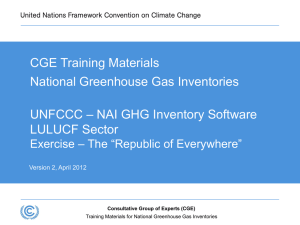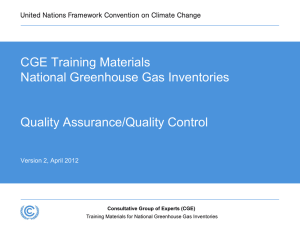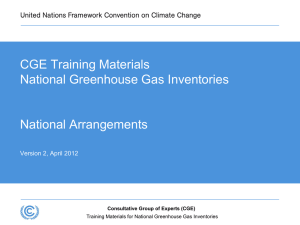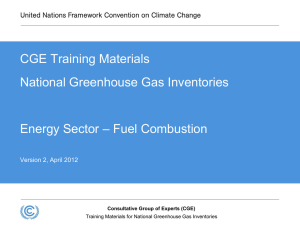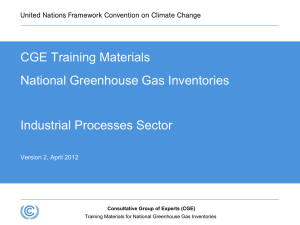IPCC EFDB
advertisement
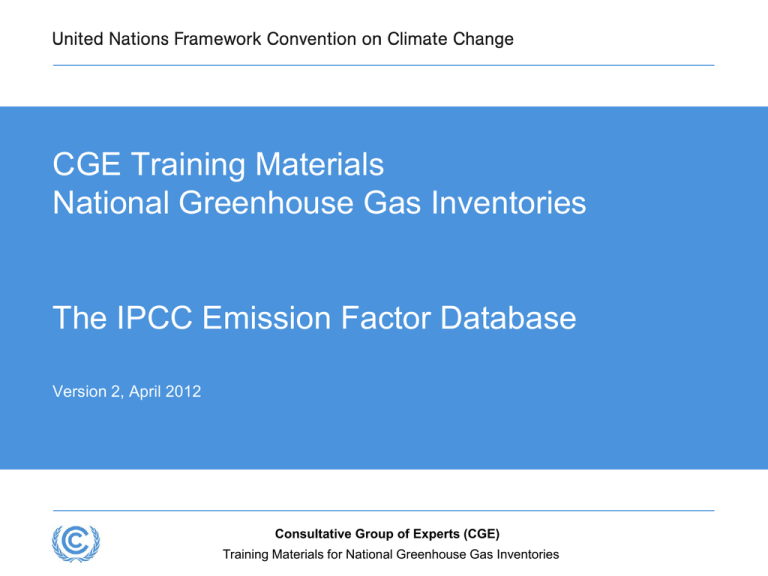
CGE Training Materials National Greenhouse Gas Inventories The IPCC Emission Factor Database Version 2, April 2012 Consultative Group of Experts (CGE) Training Materials for National Greenhouse Gas Inventories Target Audience and Objective of the Training Materials These training materials are suitable for people with beginner to intermediate level knowledge of national greenhouse gas (GHG) inventory development. After having read this presentation, in combination with the related IPCC EFDB User Manual, the reader should: Have an overview of how to use the IPCC EFDB Have a general understanding of the IPCC EFDB Be able to determine which methods suits her/his country’s situation best Know where to find more detailed information on this topic. These training materials have been developed on the basis of documents developed by the IPCC; hence the reader is always encouraged to refer to the original documents to obtain further detailed information on a particular issue. Consultative Group of Experts (CGE) Training Materials for National Greenhouse Gas Inventories 2 Acronyms EFDB IPCC Emission Factor Database REDD Reducing Emissions from Deforestation and forest Degradation SBI Subsidiary Body for Implementation SBSTA Subsidiary Body for Scientific and Technological Advice TSU Technical Support Unit Consultative Group of Experts (CGE) Training Materials for National Greenhouse Gas Inventories 3 Estimating Emissions IPCC Guidelines contain global or regional default values (mostly for Tier 1) based on the best science when the guidelines were compiled. Emissio Facto * Activ Factor from IPCC defaults or national information Activity from national or international statistics Higher tier estimates need country-specific factors based on: Situation in country, methods, management etc Latest science and best practice elsewhere Latest mitigation being applied. Consultative Group of Experts (CGE) Training Materials for National Greenhouse Gas Inventories 4 However, … It is expensive to measure all the factors used. Even just for key categories, this would often would be prohibitive. It would be more efficient to use values developed elsewhere for similar circumstances. Emission factors and other parameters may not be easily accessible. Data may be in the appropriate peer-reviewed literature, but this is not always widely accessible. Other data may be in less easy-to-find reports. Consultative Group of Experts (CGE) Training Materials for National Greenhouse Gas Inventories 5 The Emission Factor Database The IPCC Emission Factor Database (EFDB) aims to: Be a library of parameters useful to inventory compilers: Both peer reviewed and other reports; Provide sufficient information to judge whether the data may be applicable to specific circumstances; Give references to source documents so users can judge whether the data can be used in their situation; Be freely available to all: Web version as well as CD; Allow anyone to provide data to share with other users: Data evaluated by Editorial Board; Users are responsible for checking that data are appropriate to their circumstances. Consultative Group of Experts (CGE) Training Materials for National Greenhouse Gas Inventories 6 The Growing Importance of the EFDB In the context of revision of the UNFCCC Annex I reporting guidelines, the SBSTA32 welcomed the work of the IPCC to facilitate the use of the 2006 IPCC Guidelines, including its efforts to develop inventory software and the Emission Factor Database. It invited the IPCC and other relevant organizations to strengthen their efforts in this area. (FCCC/SBSTA/2010/6, paragraph 76). In the context of REDD discussion, the SBSTA32 requested the UNFCCC secretariat to work with the IPCC on promoting the use of the IPCC Emission Factor Database. (FCCC/SBSTA/2010/6, paragraph 40). In the context of national communications from non-Annex I Parties (NAI-NC), the Consultative Group of Experts (CGE): Agreed on the usefulness of the Emission Factor Database; and Recommended improvement of data quality by the enhancement of the sharing of country-specific emission factors through the Emission Factor Database among NAI Parties, as an element to be considered in a future revision of the NAI-NC Guidelines. (FCCC/SBI/2011/5/Rev.1) Consultative Group of Experts (CGE) Training Materials for National Greenhouse Gas Inventories 7 Data contained in the EFDB At present, the EFDB contains the IPCC default data (from the Revised 1996 IPCC Guidelines, IPCC good practice guidance reports and the 2006 IPCC Guidelines). Additional data from the global scientific and inventory society are also included. New data will be evaluated for acceptance by the EFDB Editorial Board according to the following criteria: The EFDB should assist countries in producing inventories that are neither over- nor underestimates so far as can be judged and in which uncertainties are reduced as far as practicable. To this end, the data are assessed by the Editorial Board to see if they are robust, applicable and documented This is not a full scientific review. Consultative Group of Experts (CGE) Training Materials for National Greenhouse Gas Inventories 8 Comparison of IPCC Default and EFDB Data: Enteric Fermentation, Dairy Cows 25 140 120 Number of values 100 15 80 60 10 40 CH4 Emission factor, kg/head/yr Data presented as: 20 5 20 0 0 IPCC Finland IPCC Argentina IPCC Kenya Consultative Group of Experts (CGE) Training Materials for National Greenhouse Gas Inventories 9 Populating the EFDB Editorial Board Data Provider Data Form Data Data Data Data Data Meeting with EB TSU Defaults Literature Search Consultants EFDB Consultative Group of Experts (CGE) Training Materials for National Greenhouse Gas Inventories 10 How Data can be Submitted The IPCC welcomes data proposals from everyone. The website has details and forms with single data and bulk data entry but… The simplest way is to send an email with details to TSU with details at: nggiptsu@iges.or.jp. After receipt by TSU: Data are reviewed by the Editorial Board (EB) The EB contact the data provider for more information If the data meet the criteria they are published in the database. Consultative Group of Experts (CGE) Training Materials for National Greenhouse Gas Inventories 11 EB Criteria for New Data Robust Within the accepted uncertainty, the value is unlikely to change if there was repetition of the original measurement programme or modelling activity. “Properties” Applicable An emission factor can only be applicable if the source and its mix of technology, operating and environmental conditions and abatement and control technologies under which the emission factor was measured or modelled are clear and allow the user to see how it can be applied. Documented Access information to the original technical reference must be provided to evaluate the robustness and applicability as described above. Consultative Group of Experts (CGE) Training Materials for National Greenhouse Gas Inventories 12 Robustness Specific issues concerning robustness are, for example: Are the measurement techniques including raw data validated and/or verified? Are the modelling techniques including supporting data validated and/or verified? Is the conversion (if any) from model assumptions or measurement conditions to annual or other forms of emission factors or other parameters sufficiently explained and justified? Is an uncertainty assessment on the emission factor or other parameter presented? Sufficient documentation (provision of access to technical references) will help. Consultative Group of Experts (CGE) Training Materials for National Greenhouse Gas Inventories 13 Robustness Emission Factor Report (ID: 213625) Administrative information Data Provider: Data Provider Country: Data Provider Contact: Date calculated: Date submitted to EFDB by Data Provider: Date posted to EFDB by IPCC: Technical information Gas: GIO/CGER/NIES Japan aizawa.tomoyuki@nies.go.jp 2005/6/25 2006-03-27 20:05:57 Unknown NITROUS OXIDE … … Usage/Review information Type of parameter: Measurement technique/standard: Periodicity of measurement: External quality control performed: Date of measurement: Comments from the data provider: Measured The N2O decomposition ratio (same meaning as "destruction Online infrared gas analyzers and flow meters were used to continuously measure the concentrations and the flow rates of N2O entering and exiting the decomposition equipment. The instantaneous value of a measurement was recorded every few seconds. The instaneous values recorded data were used for N2O emission calculations. The independent auditing organization certified in August, 2005 that emission estimates were conducted properly and the data obtained and verified from the investigation were valid and 2004-4-1 to 2005-4-1 As 0.03% of the generated N2O gas escapes through the online infrared gas analyzer and during the first crystallization process, the remaining 99.97% is fed into decomposition equipment. In addition, 99.97% of the N2O fed is destroyed. Therefore, the overall destruction factor is 99.94% (= 0.9997 * 0.9997). Comments from others: Link: Consultative Group of Experts (CGE) Training Materials for National Greenhouse Gas Inventories 14 Applicability – “Properties” are Crucial “Properties” define what EFDB users might see as important information in order to judge whether the data are suitable for their inventories. Five types of “properties”: Technologies/practices Parameters/conditions Region/regional conditions Abatement/control technologies Others. Consultative Group of Experts (CGE) Training Materials for National Greenhouse Gas Inventories 15 Applicability – “Properties” are crucial Emission Factor Report (ID: 513626) Administrative information Data Provider: Data Provider Country: Data Provider Contact: Date calculated: Date submitted to EFDB by Data Provider: Date posted to EFDB by IPCC: Technical information Gas: Xiaoquan Zhang China xiaoquan@caf.ac.cn 2006-06-28 2006-07-11 19:33:14 2006-09-08 16:02:18 CARBON DIOXIDE IPCC 1996 Source/Sink Category: IPCC 2006 Source/Sink Category: Properties Land-Use Change & Forestry (5) -> Changes in Forest and Other Woody Biomass Stocks (5A) -> Tropical Forests (5A1) -> Plantations (5A1g) Agriculture, Forestry, and Other Land Use (3) -> Land (3.B) The rotation is around 25 years. Thinning is usually done. Other management activities include fertilizer application. Abatement/Control Technologies: Other activities include pest and disease control, and fire control Technologies/Practices: Parameters/Conditions: Tree species: Chinese fir (Cunninghamia lanceolata); age ranges from 3 to 60 year-old. Region/Regional Conditions: Country: China; Region: Southern China; Climate zone: subtropical, very moist climate; Mean annual temperature is 17°C; Mean annual precipitation is 1500mm. Others: tree height ranges from 2 to 28.1 meter, DBH from 2 to 48.1 cm Description: Value: Unit: Value in common units: Common unit: Equation: IPCC Worksheet: Source of data: Biomass Expansion Factor (BEF2) converting volumes of extracted rounwood to total aboveground biomass (overbark) for Chinese fir 1.66 (1.21 - 2.97) dimensionless (dimensionless) Equations 3.2.3, 3.2.7, and 3.2.8 in IPCC Good Practice Guidance for Land Use, Land-Use Change and Forestry Worksheet FL-1a of IPCC GPG-LULUCF compiled from Science literature (calculated from 121 studies from 39 published articles in Chinese Journals Consultative Group of Experts (CGE) Training Materials for National Greenhouse Gas Inventories 16 Documentation Sufficient information on technical references, for example: Scientific or technical publication in an internationally available journal Report or book with an ISBN. A URL where the technical references are available will be quite helpful. Consultative Group of Experts (CGE) Training Materials for National Greenhouse Gas Inventories 17 Documentation Emission Factor Report (ID: 513034) Administrative information Data Provider: Data Provider Country: Data Provider Contact: IPCC (Not applicable) ipcc-efdb@iges.or.jp … … Technical information Gas: CARBON DIOXIDE … … Worksheet FL-1a of GPG-LULUCF IPCC Good Practice Guidance for LULUCF, Table 3A.1.10 (Default Values of Biomass Expansion Factors (BEFS)), page 3.178. Isaev et al., 1993; Brown, 1997; Brown and Schroeder, 1999; Schoene, 1999; ECE/FAO TBFRA, 2000; Lowe et al., 2000; Refer to FRA Working Paper 68 and 69 for average values for developing countries ( English IPCC Worksheet: Source of data: Technical Reference: Reference language: … … Usage/Review information Type of parameter: Comments from the data provider: Comments from others: Link: 1996 IPCC default Data applicable to Forest Land Remaining Forest Land (5FL-1) and to Land Converted to Forest Land (5-FL-2) http://www.fao.org/forestry/index.jsp Consultative Group of Experts (CGE) Training Materials for National Greenhouse Gas Inventories 18 Enhancement and Improvement Continuing efforts for data population: The IPCC welcomes data from anyone Meetings to collect data are held, in principle, twice every year Up-to-date data/information relevant to “2013 Supplement to the 2006 IPCC Guidelines for National Greenhouse Gas Inventories: Wetlands” will be included. Improvement to the EFDB user-interface, etc.: Navigability of data search process will be improved User-friendliness of data input process will be improved. Consultative Group of Experts (CGE) Training Materials for National Greenhouse Gas Inventories 19 Summary The EFDB is a library of data that may provide more accurate parameters for your national inventory. Users MUST check themselves whether data are applicable to their circumstances. The IPCC is actively requesting anyone with suitable data to submit it. Data will be assessed for robustness, applicability and documentation – not a full scientific review. The IPCC is planning improvements to the EFDB. Consultative Group of Experts (CGE) Training Materials for National Greenhouse Gas Inventories 20 Thank you Consultative Group of Experts (CGE) Training Materials for National Greenhouse Gas Inventories 21



